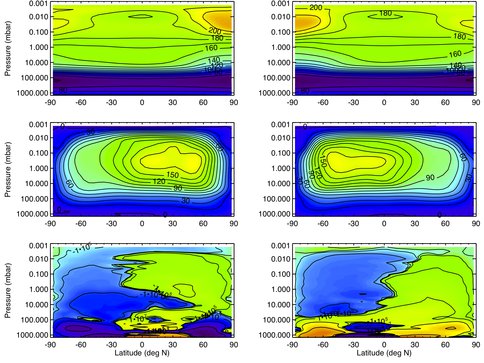2011 Annual Science Report
 NASA Jet Propulsion Laboratory - Titan
Reporting | SEP 2010 – AUG 2011
NASA Jet Propulsion Laboratory - Titan
Reporting | SEP 2010 – AUG 2011
Task 2.1.2.1 Atmospheric State and Dynamics
Project Summary
The chemical model requires a description of the background state of the atmosphere, specifically temperature and circulation as a function of latitude and longitude.
Project Progress
Co-Investigator Claire Newman in collaboration with Co-Investigator Mark Richardson seeks to produce realistic Titan atmospheric profiles [winds, temperatures and densities] from the surface to ~1200km, for a variety of seasons and solar cycles, for use by other members of the NAI Titan project.
Their proposed approach was to combine results from a lower/middle atmosphere Titan model [TitanWRF], extending from the surface to ~430km, with results from an upper atmosphere model [the Titan General Circulation model (TGCM), run by Ingo Müller-Wodarg at Imperial College London], which extended from ~600 to >1200km. Taking results from these models run separately and interpolating over the gap region is highly undesirable for two reasons: (i) molecular diffusion and UV heating become increasingly important (and haze absorption / scattering of solar radiation decreasingly important) with altitude over the gap region, thus profiles are expected to have far more complex variations than produced using simple interpolation; and (ii) in reality the lower atmospheric circulation impacts the upper atmospheric flow, thus running the models completely separately is highly inconsistent.
In the past year, to address (i), the TGCM has been run with its lower boundary shifted downward to eliminate the gap region. This enables future work to include more lower atmosphere radiative processes (e.g. haze absorption and scattering) into the TGCM to provide more realistic profiles over this region. To address (ii) they have developed a ‘model coupling’ framework to force the lower boundary of the TGCM using previously generated output from the upper portion of TitanWRF. Newman et al. have run TitanWRF to generate the required input dataset, and are currently testing this with the TGCM.
In the past year they have published TitanWRF results [Newman et al., 2011; see Figures 1 and 2]. TitanWRF now successfully reproduces the observed amount of stratospheric superrotation, a fundamental requirement for the model coupling to produce realistic results.
Figure 1: Zonal-mean temperatures (in K, top row), zonal winds (in m/s, middle row) and mass streamfunctions (in kg/s, bottom row) averaged over 12 Titan days around northern summer (Ls~90°, left column) and winter (Ls~270°, right column) solstice. Positive streamfunction values indicate clockwise rotation.
Figure 2: As in Figure 1 but for northern spring (Ls=0°, left) and fall (Ls=180°, right) equinoxes.
Publications
-
Newman, C. E., Lee, C., Lian, Y., Richardson, M. I., & Toigo, A. D. (2011). Stratospheric superrotation in the TitanWRF model. Icarus, 213(2), 636–654. doi:10.1016/j.icarus.2011.03.025
-
PROJECT INVESTIGATORS:
-
RELATED OBJECTIVES:
Objective 1.1
Formation and evolution of habitable planets.
Objective 2.2
Outer Solar System exploration
Objective 3.1
Sources of prebiotic materials and catalysts


